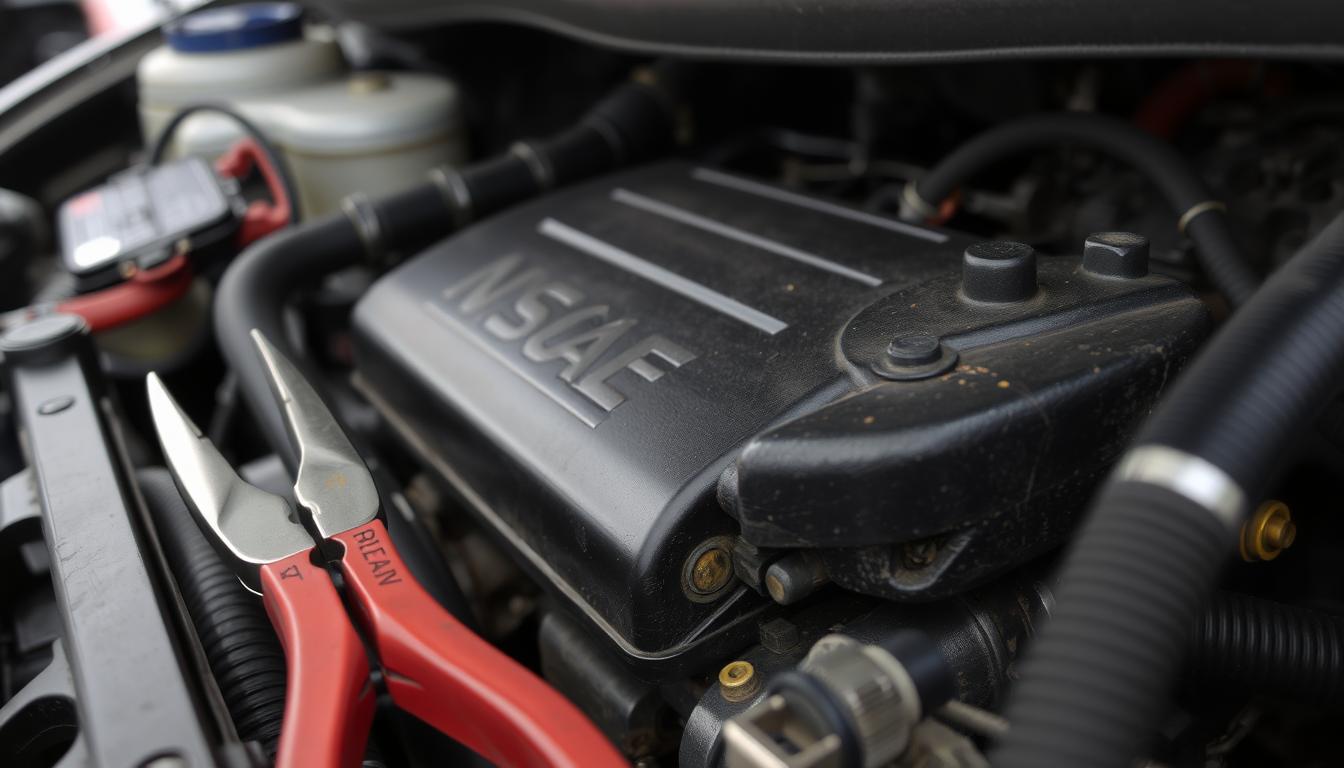Nissan car owners often face issues with the fusible link. These problems can make the car hard to drive. They can be caused by the link getting old or damaged by heat.
A cheap fix might work, but knowing why it broke is key. The alternator’s connector looked fine, but losing the S terminal connection stopped the alternator from working. This shows how important a good connection is.
Fixing electrical problems in Nissan cars is vital. This guide will help you understand and solve these issues.
Introduction to Nissan Fusible Link Problems
Dealing with Nissan fusible link problems can be tough. But, with the right tools and knowledge, you can fix them. This guide aims to make Nissan electrical issues clear and offer solutions.
Key Takeaways
- Nissan fusible link problems can cause Nissan electrical issues
- Age and heat damage can lead to fusible link failure
- A proper connection is essential for the alternator’s output
- A $10 replacement plug can sometimes fix similar problems
- Understanding the root cause of the issue is crucial for effective repair
- Nissan vehicle owners can benefit from a comprehensive guide to resolving fusible link problems
Understanding Nissan Fusible Links
Fusible links are key to keeping your Nissan’s electrical system safe. They prevent electrical issues from causing bigger problems in your car.
What is a Fusible Link?
A fusible link is a special fuse that protects your car’s electrical parts. It’s different from regular fuses because it’s made of a short wire. This wire melts if too much current flows through, stopping damage to your electrical system.
Function in Electrical Systems
In Nissan cars, fusible links protect against electrical overloads. They’re made to handle sudden high current spikes. This keeps important parts like the starter motor and alternator safe from damage caused by power surges or short circuits.
Locations in Nissan Vehicles
Fusible links are usually found near the battery or alternator. Their placement helps protect the main electrical paths. This makes it easier to fix electrical issues and reduces the risk of system failure.
| Feature | Fusible Links | Standard Fuses |
|---|---|---|
| Wire Gauge | Four gauges higher (smaller) than circuit | Varies based on application |
| Current Handling | Handles higher peak currents briefly | Handles constant lower currents |
| Location | Near battery or alternator | Within the fuse box |
| Appearance | Smaller diameter, different color | Varies, often colored for identification |
| Purpose | Protect wiring harness and major components | Protect specific circuits and accessories |
Common Signs of Nissan Fusible Link Problems
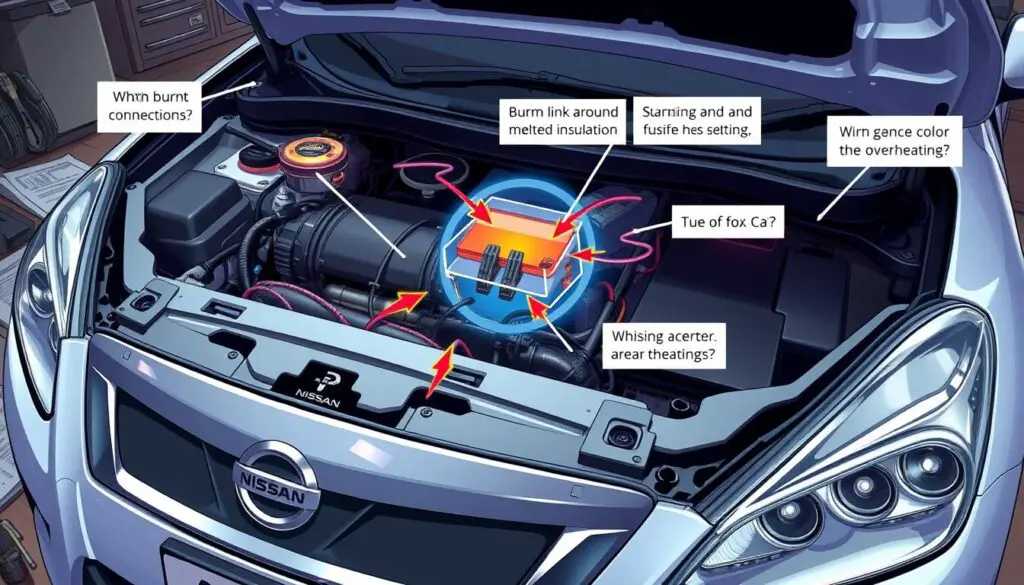
Having a sudden Nissan electrical issue can be really frustrating. Spotting the Nissan fusible link symptoms early can help avoid more damage to your car.
- Loss of Electrical Power: A clear sign is when all electrical functions, like lights and dashboard indicators, stop working.
- Alternator Failure: If the alternator fails, your car won’t charge the battery, causing the engine to stall.
- Blown Fuses: Often, blown fuses mean a bad fusible link, messing with many electrical systems.
A 2011 Nissan Note dci owner faced a total electrical failure after just 100 yards. The problem was with ‘Fuse B.’ This is common in Nissan Micras because of a design flaw in the fusible link holder. It leads to corrosion.
To figure out these problems, follow these steps:
- Look for any blown fuses in the main electrical systems.
- Check if the alternator is charging correctly.
- Search for corrosion or damage on the fusible links.
| Symptom | Possible Cause | Recommended Action |
|---|---|---|
| Loss of Electrical Power | Blown fusible link | Replace the fusible link and check for other problems |
| Alternator Failure | Faulty fusible link causing charging issues | Test the alternator and replace if needed |
| Blown Fuses | Overloaded fusible link | Find and fix the cause of the overload |
The Role of Fusible Links in Vehicle Protection
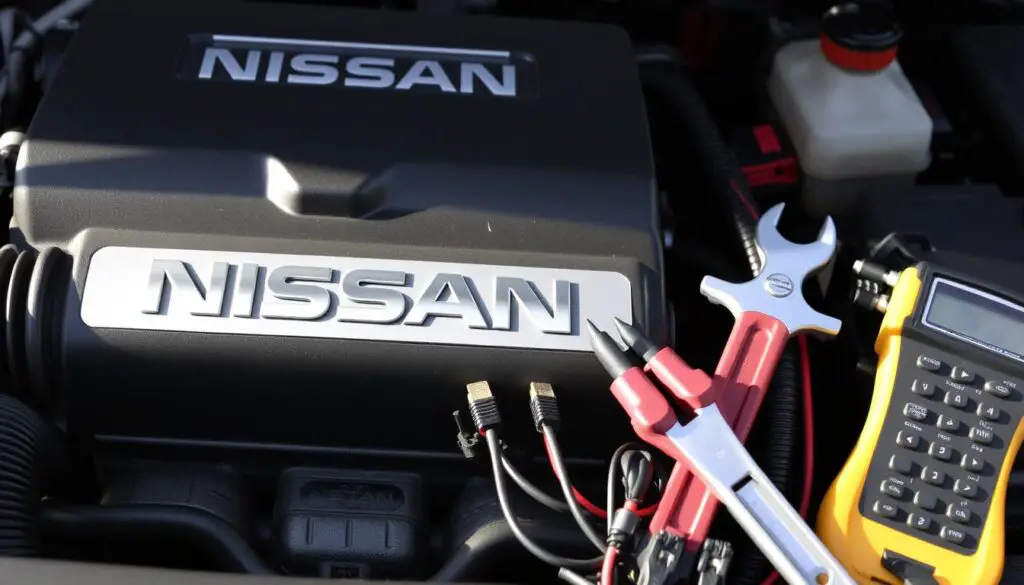
Fusible links are key to protecting your Nissan’s electrical system. They are weak points in the wiring. They break the circuit before damage gets worse during electrical surges or short circuits.
Circuit Protection Mechanisms
When there’s a sudden increase in current, fusible links melt to stop the circuit. This stops too much current from harming sensitive parts, avoiding Nissan electrical system failure. Unlike regular fuses, fusible links can handle brief, high currents well. This makes them perfect for cars where such spikes happen often.
Comparison with Standard Fuses
Fusible links are different from standard fuses in several ways:
- Design: They use a wire that’s four gauges higher than the rest of the circuit. This makes them fail first.
- Cost-Effectiveness: They’re cheaper and easier to put in than dedicated fuse blocks.
- Durability: Fusible links can handle changing current loads better without failing too soon.
For good Nissan fuse link troubleshooting, knowing these differences is key. Keeping fusible links in good shape and replacing them on time can save you money. It also keeps your car’s electrical system running well for longer.
| Feature | Fusible Links | Standard Fuses |
|---|---|---|
| Design | Wire with higher gauge | Single element |
| Cost | More cost-effective | Generally higher |
| Installation | Easy to install | Requires fuse blocks |
| Current Handling | Handles momentary spikes | Fixed rating |
| Durability | More durable under variable loads | Less adaptable |
Diagnosing Fusible Link Issues
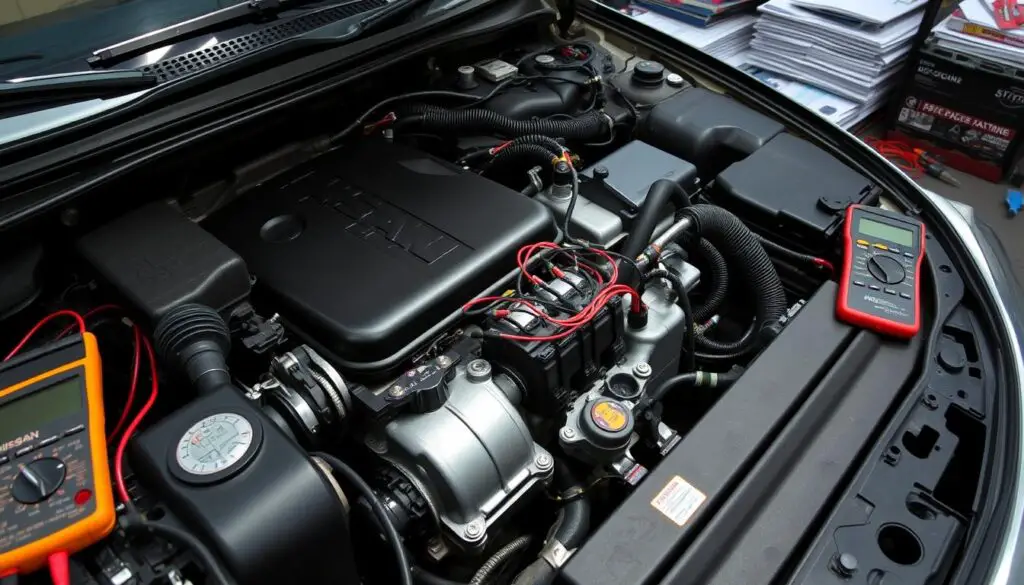
Having a Nissan fusible link problem can mess up your car’s electrical system. To fix it, start by looking closely at the wiring harness for fusible links. Make sure to turn off the engine and disconnect the battery first for safety.
- Turn off the engine and disconnect the battery to ensure safety.
- Inspect the fusible links for any visible signs of damage, such as burns or breaks.
- Use a multimeter to test the continuity of each fusible link. A lack of continuity indicates a faulty link.
- Replace any damaged fusible links with the appropriate gauge wire to restore functionality.
It’s key to fix Nissan fuse link problems right to keep your car running well. Fusible links protect your wiring from too much electricity. By checking them often and replacing them when needed, you avoid big repair costs and keep your car in top shape.
| Aspect | Details |
|---|---|
| Cost | A few dollars per fusible link |
| Replacement Time | Approximately 30 minutes |
| Function | Protects against electrical overloads by failing before wiring harness |
| Current Rating | Used for momentary higher peak current levels (up to 40 amps) |
| Material | Wire four gauges higher (smaller) than the circuit |
| Appearance | Resembles regular wires, making them challenging to troubleshoot |
| Installation | Requires proper weather-proofing for longevity |
Most Common Causes of Fusible Link Failure
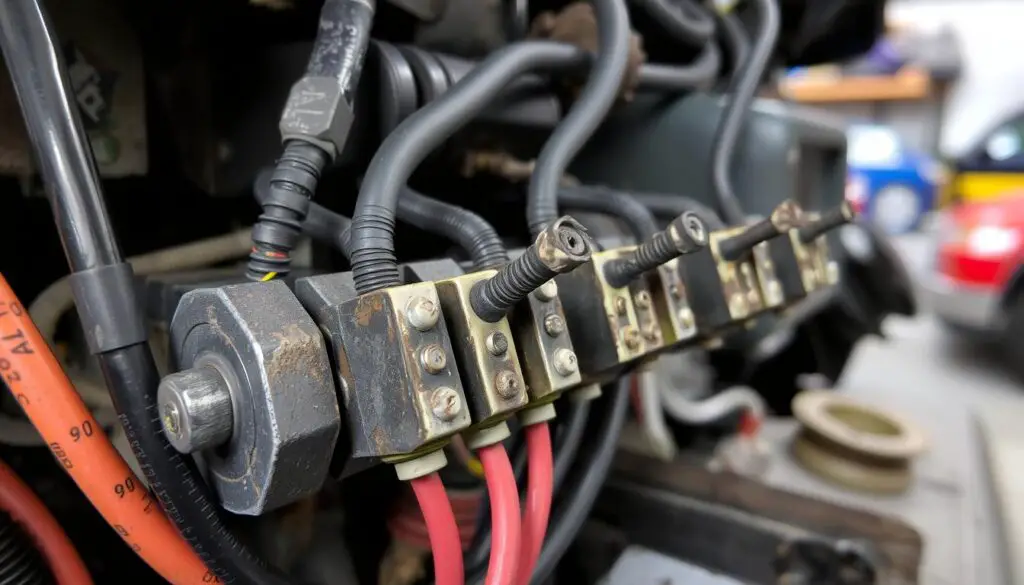
Fusible link failures in Nissan vehicles can cause big problems with the electrical system. Knowing why they fail helps avoid future issues.
Electrical Overload Scenarios
Too many devices using power at once can overload the electrical system. This is a main reason for Nissan fusible link problems. For example, a 2011 Nissan Note DCI had a total electrical failure after just 100 yards because of this.
Physical Damage Factors
Corrosion is a big problem, like in the Nissan Micra. The fusible link holder, found under the nearside headlamp in 2003 Micra K12 models, can corrode badly. Fixing this damage might need special parts, like the fusible link holder part number 243807994B, which might be hard to find.
Age-Related Deterioration
As cars get older, fusible links can start to fail. Extreme temperatures and regular use weaken them. A certified mechanic can check for signs of wear early, helping avoid sudden electrical failures.
Testing Your Nissan’s Fusible Link
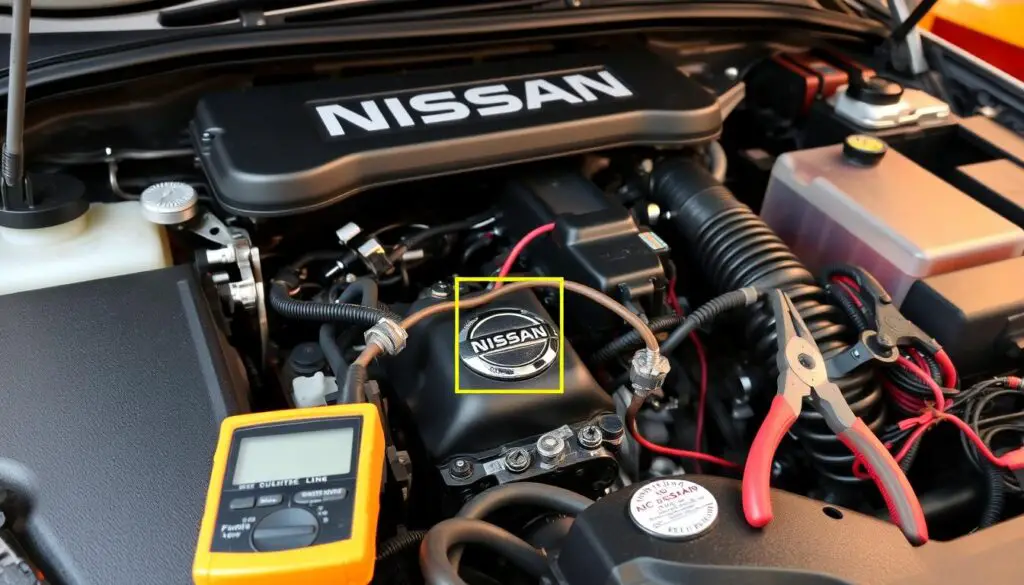
Knowing the Nissan fusible link symptoms is key to keeping your car’s electrical system working right. Begin your Nissan fuse link troubleshooting by getting the right tools. You’ll need a good multimeter.
Here’s how to check your fusible links:
- Locate the Fusible Links: You’ll find six fusible links in the black fuse box behind the Positive (+) Battery post.
- Set Up Your Multimeter: Make sure your multimeter is set to the continuity mode.
- Test for Continuity: Put the multimeter probes on both ends of the fusible link. If you hear a continuous buzzer, it’s good.
- Check Resistance: Change the multimeter to resistance mode. A healthy fusible link should have low resistance, less than 1 ohm.
- Interpret Results: If you don’t hear a sound or see high resistance, the fusible link is blown and needs to be replaced.
Learning these steps can help you spot problems with Nissan fusible link symptoms quickly. Regular checks keep your car’s electrical systems running smoothly, avoiding breakdowns.
| Multimeter Setting | Expected Reading | Interpretation |
|---|---|---|
| Continuity | Buzzer sound | Fusible link is intact |
| Resistance | Under 1 Ohm | Healthy fusible link |
| Resistance | No sound or High Resistance | Fusible link is blown |
Step-by-Step Inspection Process
Checking the fusible links in your Nissan is key to avoiding electrical problems. Good Nissan fuse link troubleshooting can spot early signs of a Nissan fusible link problem.
Required Tools
- Multimeter
- Screwdrivers
- Protective gloves
- Wire brush
Safety Precautions
- Disconnect the battery before starting
- Wear protective gloves and eyewear
- Avoid working on a live electrical system
Visual Inspection Guidelines
- Check for signs of burning or discoloration
- Look for loose or corroded connections
- Ensure fusible links are securely connected
By following this Nissan fuse link troubleshooting guide, you can catch a Nissan fusible link problem early. This keeps your vehicle reliable and safe.
Professional vs DIY Replacement Options
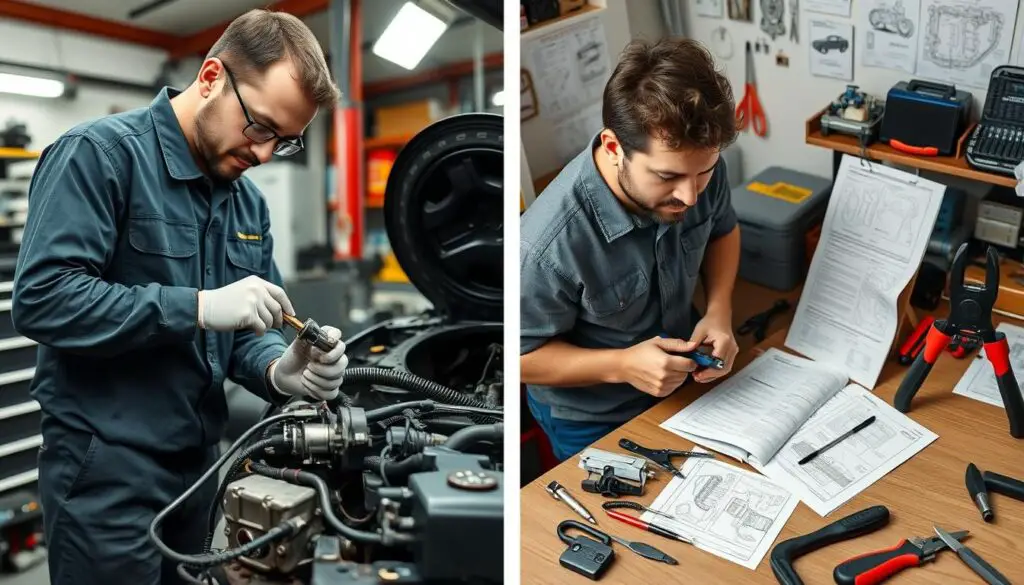
Choosing between Nissan fusible link repair by a pro or doing a Nissan fusible link replacement yourself depends on many things.
- Pros: Experts do the job right, get quality parts, and save time.
- Cons: It costs more than DIY, you need to schedule it, and you rely on the mechanic’s time.
DIY Replacement:
- Pros: It’s cheaper, you can do it when you want, and you feel proud of it.
- Cons: You need to know how to do it, there’s a risk of mistakes, and it might void your warranty.
| Aspect | Professional Replacement | DIY Replacement |
|---|---|---|
| Cost | Higher due to labor fees | Lower, only parts and tools |
| Complexity | Handled by experts | Requires technical skills |
| Time | Quicker with professional help | Depends on your experience |
| Risk | Minimal if done by a professional | Higher chance of errors |
Replacing a Blown Fusible Link
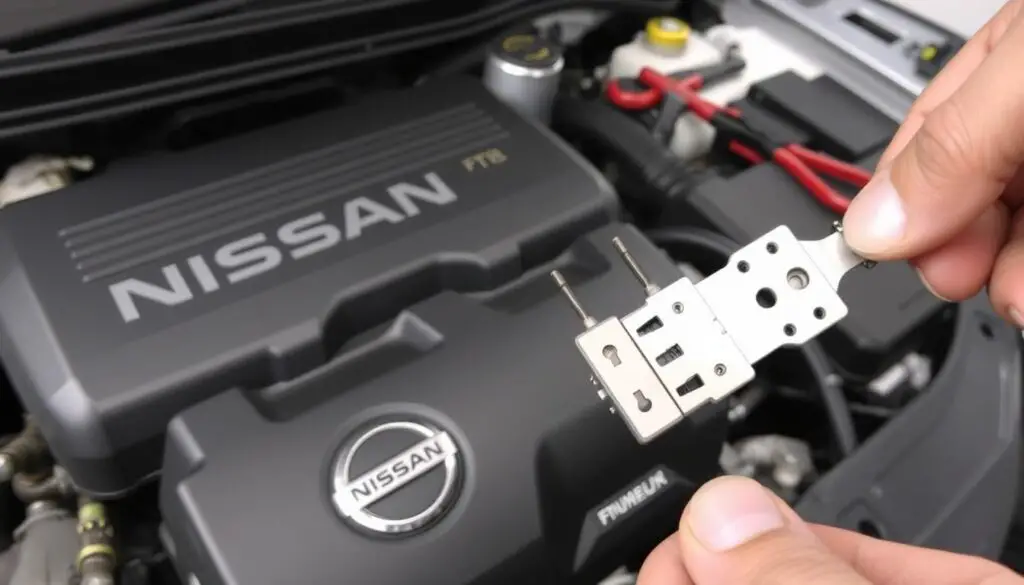
Fixing a blown fusible link in your Nissan is key to keeping your car’s electrical system working right. Follow these steps for a successful Nissan fusible link replacement.
Removal Process
First, disconnect the vehicle’s battery for safety. Find the faulty fusible link, usually near the battery or fuse box. Then, remove the old link by unclipping it from its connectors.
Installation Steps
Put the new fusible link in by connecting it to the same spots as the old one. Make sure the connections are tight and clean. It’s important to use a replacement that fits your Nissan’s specs for the best performance.
Post-Installation Checks
After installing the new link, reconnect the battery. Turn on the car and check all electrical systems. Make sure everything works as it should. Watch for any problems that might come back.
Cost Considerations for Repairs
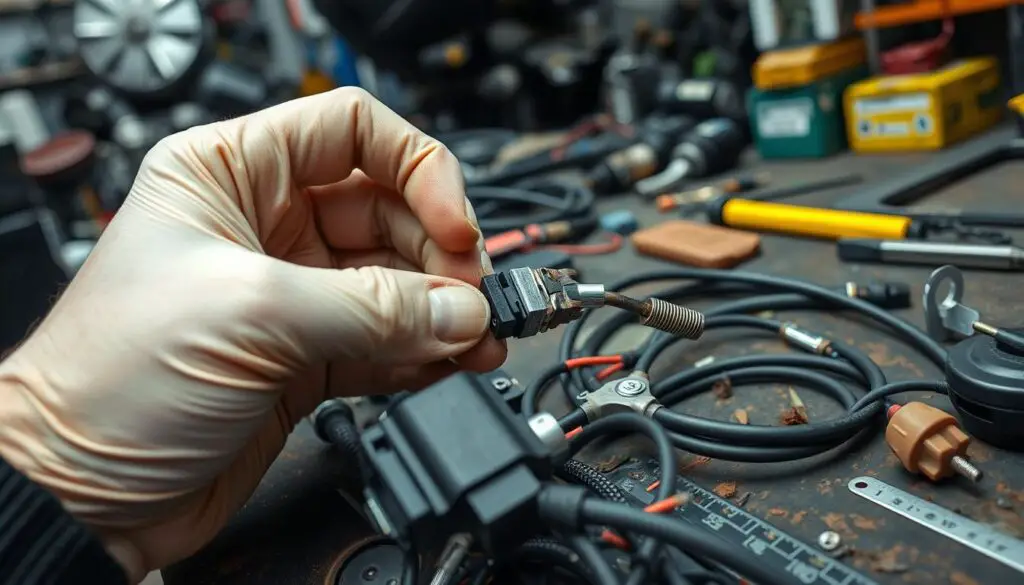
When you need a Nissan fusible link repair, knowing the costs is key. The main costs are for parts and labor. Both are important for the total repair price.
- Parts Costs: Usually, the fusible link itself is cheap. Sometimes, the parts are included in the labor fee.
- Labor Costs: A Nissan fusible link replacement typically costs about $95 for labor. This price is the same for models like the Nissan Kicks and Nissan Versa Note.
- Additional Expenses: Sometimes, more problems are found during the repair. This can make the total cost go up.
“We offer a 12-month, 12,000-mile guarantee on all repairs, ensuring peace of mind for our customers.”
Think about the life of other parts, like the battery. A battery usually lasts three to four years. Keeping up with maintenance can avoid extra costs and keep your Nissan’s electrical system working well.
Knowing these costs helps Nissan owners get ready for Nissan fusible link replacement. It keeps your car safe and running well.
Preventing Future Fusible Link Issues
Keeping your Nissan’s electrical system in good shape is key to avoiding fusible link problems. Regular care can stop unexpected failures and keep your car running smoothly.
Maintenance Tips
- Keep the engine bay clean to reduce the risk of corrosion on wire harnesses.
- Regularly inspect fusible links, specially in older models like the 86-89 vans where FL 1.25B links are common problem areas.
- Ensure all connections are tight and free from moisture by using silicone sealant and shrink-wrapping when necessary.
- Replace any worn or damaged wires promptly to prevent Nissan electrical system failure.
Warning Signs to Watch
- Dashboard lights remain on without the starter engaging.
- Difficulty in starting the vehicle or the key not functioning correctly.
- Partial electrical functions, such as some accessories not working when the car is on.
- Visible corrosion or wear on the wiring near the battery box.
| Fusible Link Type | Rating (Amps) | Function | Replacement Cost |
|---|---|---|---|
| FL 1.25B | 1.25B | Common in 86-89 vans | $15 (Toyota) |
| FL 0.5G | 20A | Various circuits | $2.95 (Summit Racing) |
| EFI | 30A | ECU and fuel injection | — |
| AM2 | 30A | Ignition components | — |
| Headlight | 40A | Headlight circuits | — |
| AM1 | 60A | Accessories and starter solenoid | — |
| FL 2.0L | — | Powers all other fusible links except FL 0.5G | — |
Model-Specific Considerations
Nissan cars face Nissan fusible link problems in unique ways, depending on the model. Knowing these differences helps fix specific Nissan electrical issues better.
The 2011 Nissan Note dci has an electrical failure that can happen after just 100 yards of driving. Owners say there’s a sudden power loss, which is tied to the fusible link. Fixing this usually costs about £44.96 including VAT. But, getting new parts can take over a week, leading some to try temporary fixes like soldering the link.
Soldering is cheaper but might not last long or work well. It could harm the car’s electrical system.
The Nissan Micra also has Nissan fusible link problems. These cars often get severe corrosion in the fusible link holder. This corrosion can cause power failures and other issues. Keeping the parts clean and replacing them when needed is key to avoiding more Nissan electrical issues.
For the E11 Note 1.5dci, fixing the fusible link needs specific parts. This shows why using parts made for your model is crucial for good electrical performance. Knowing these model-specific issues helps Nissan owners keep their car’s electrical system in top shape.
Common Mistakes to Avoid
When you’re replacing a Nissan fusible link or trying to fix a Nissan fuse link, it’s key to avoid common mistakes. These errors can make repairs not work and even be dangerous.
Installation Errors
One big problem in Nissan fusible link troubleshooting is bad installation. If connections aren’t done right, you might face electrical issues or system failures.
- Always make sure fusible links are well connected with no loose ends.
- Use the right tools to avoid damaging the terminals when installing.
- Check the placement as the factory service manual suggests to avoid mistakes.
Selection Mistakes
Choosing the wrong fusible link can harm your car’s electrical system. Picking parts that don’t fit the manufacturer’s specs can lead to poor protection and failures.
- Check the factory service manual to find the right fusible link type and gauge.
- Buy fusible links from trusted suppliers to ensure quality and fit.
- Don’t use aftermarket parts that don’t meet OEM standards, as they might not last.
When to Seek Professional Help
If you see dim lights, a failing battery, or check engine lights, it might mean your Nissan’s electrical system is failing. Trying to fix a Nissan fusible link repair yourself can be tough and risky.
Think about getting professional help if:
- You keep replacing fusible links.
- You face complex electrical problems that need more than basic fixes.
- You notice signs of short circuits or issues with the central locking system.
Experts can do accurate diagnostics and find the real problem. They use special tools and know how to handle Nissan’s electrical systems well. This reduces the chance of more damage.
| Aspect | DIY Repair | Professional Repair |
|---|---|---|
| Accuracy | Variable | High |
| Safety | Risk of electrical hazards | Ensured by experts |
| Cost | Lower upfront | Potentially higher but cost-effective long-term |
| Time | May take longer without expertise | Efficient and timely |
Getting professional help quickly can stop small problems from getting bigger. It saves you time and money and keeps your Nissan running well.
Emergency Temporary Solutions
Dealing with a Nissan fusible link problem on the road can be scary. Knowing what to do first can keep you safe until you can get it fixed.
Safe Temporary Fixes
- Battery Check: Make sure your battery is fully charged. A weak battery can make electrical problems worse.
- Fuse Inspection: Look for signs of wear or damage on nearby fuses. Replace them if you find any.
- Secure Connections: Tighten any loose electrical connections to prevent more problems.
These steps can help fix the Nissan electrical issue for now. They let you drive to a repair shop safely.
What Not to Do
- Avoid DIY Electrical Repairs: Trying to fix complex electrical problems yourself can cause more harm.
- Do Not Ignore Warning Signs: Ignoring flickering lights or strange sounds can be dangerous.
- Refrain from Using Improvised Parts: Using parts not made for your car can lead to more electrical failures.
By avoiding these actions, you won’t make the Nissan fusible link problem worse. Or create new electrical dangers.
Conclusion
Keeping your Nissan’s fusible links in good shape is key to avoiding electrical system failures. Fixing a Nissan fusible link problem quickly can save you from expensive repairs and unexpected breakdowns. Issues often need a new fusible link and relay assembly, which is crucial for battery and ignition problems.
Regular checks and proper care can spot problems early. Look out for signs like the car only starting after you touch the EGI relay or the battery draining fast. These signs usually mean there’s a bigger electrical issue that needs fixing right away.
Whether you fix it yourself or get a pro, knowing how to deal with fusible link problems helps keep your Nissan running well. Stay ahead by following maintenance tips and fixing any warning signs fast. This way, you ensure your vehicle’s electrical system lasts long and works reliably.
FAQ
What is a fusible link in a Nissan vehicle?
What are the common symptoms of a Nissan fusible link problem?
How do fusible links differ from standard fuses in Nissan vehicles?
Where are fusible links typically located in Nissan vehicles?
How can I diagnose a fusible link issue in my Nissan?
What are the most common causes of fusible link failure in Nissan vehicles?
Can I replace a blown fusible link myself, or should I seek professional help?
What tools are required for inspecting fusible links in a Nissan?
How much does it cost to replace a fusible link in a Nissan?
What maintenance can prevent future fusible link problems in my Nissan?
Do fusible link issues vary across different Nissan models?
What are common mistakes to avoid when replacing a fusible link in a Nissan?
When should I seek professional help for fusible link problems in my Nissan?
Are there any emergency temporary solutions for a blown fusible link in a Nissan?

Jack Thompson is a writer and seasoned auto mechanic with over 15 years of experience in the automotive industry. Known for his expertise in vehicle mechanics, Jack has a deep understanding of car and truck systems. His skills, honed through years of hands-on experience, have made him a trusted name in the field. Jack is committed to providing valuable insights into car maintenance and repair, helping vehicle owners keep their vehicles in top condition.

